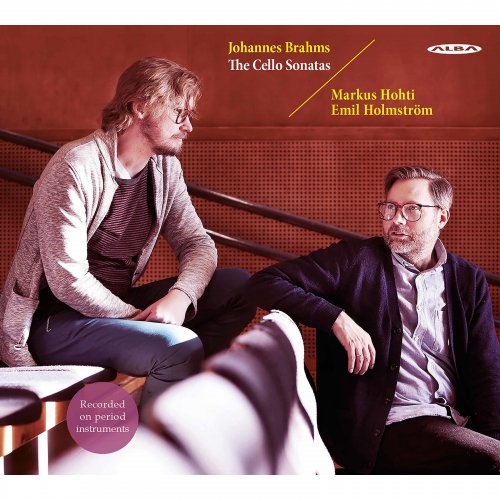
Emil Holmström and Markus Hohti - Brahms: Cello Sonatas (2020)
BAND/ARTIST: Emil Holmström, Markus Hohti
- Title: Brahms: Cello Sonatas
- Year Of Release: 2020
- Label: Alba
- Genre: Classical
- Quality: flac lossless +Booklet
- Total Time: 00:53:22
- Total Size: 237 mb
- WebSite: Album Preview
Tracklist
01. Cello Sonata No. 1 in E Minor, Op. 38: I. Allegro non troppo
02. Cello Sonata No. 1 in E Minor, Op. 38: II. Allegretto quasi Menuetto
03. Cello Sonata No. 1 in E Minor, Op. 38: III. Allegro
04. Cello Sonata No. 2 in F Major, Op. 99: I. Allegro vivace
05. Cello Sonata No. 2 in F Major, Op. 99: II. Adagio affettuoso
06. Cello Sonata No. 2 in F Major, Op. 99: III. Allegro passionato
07. Cello Sonata No. 2 in F Major, Op. 99: IV. Allegro molto
On their new release, cellist Markus Hohti and pianist Emil Holmström perform Brahms' two cello sonatas on period instruments. The sonatas were composed at very different stages of the composer’s musical career. The sonata in E minor is the first ‘duo sonata’ that Brahms wrote, and the music still exudes a sense of the Romantic unpredictability so typical of his earlier output, a phenomenon that appears, for instance, in momentary shifts to what might even be considered naïve compositional solutions. The F major sonata, meanwhile, is the work of a mature, experienced composer; it revels in compositional fun and games, and one of its most prominent features is the virtuosic approach to the instrumental writing. In the booklet Markus Hohti writes: “Brahms’ cello sonatas have been recorded hundreds of times before. Why, then, produce another recording? With this recording, we wish to leave our own mark on the interpretative continuum of Brahms’ works. That continuum consists partly of received wisdom passed from one generation to the next, possibly even from the composer himself, partly of musicians’ own interpretations, and the influence of trends pervasive at different times. […] Many clichés are used to describe Brahms’ music; people commonly refer to the ‘warmth of its sound’. It would appear that such banalities have come about over time through the gradual shift in artistic ideals and the changing sound world of modern instruments. It is time to open our ears and find new words to define Brahms’ music, words that describe how the music might originally have sounded.”
01. Cello Sonata No. 1 in E Minor, Op. 38: I. Allegro non troppo
02. Cello Sonata No. 1 in E Minor, Op. 38: II. Allegretto quasi Menuetto
03. Cello Sonata No. 1 in E Minor, Op. 38: III. Allegro
04. Cello Sonata No. 2 in F Major, Op. 99: I. Allegro vivace
05. Cello Sonata No. 2 in F Major, Op. 99: II. Adagio affettuoso
06. Cello Sonata No. 2 in F Major, Op. 99: III. Allegro passionato
07. Cello Sonata No. 2 in F Major, Op. 99: IV. Allegro molto
On their new release, cellist Markus Hohti and pianist Emil Holmström perform Brahms' two cello sonatas on period instruments. The sonatas were composed at very different stages of the composer’s musical career. The sonata in E minor is the first ‘duo sonata’ that Brahms wrote, and the music still exudes a sense of the Romantic unpredictability so typical of his earlier output, a phenomenon that appears, for instance, in momentary shifts to what might even be considered naïve compositional solutions. The F major sonata, meanwhile, is the work of a mature, experienced composer; it revels in compositional fun and games, and one of its most prominent features is the virtuosic approach to the instrumental writing. In the booklet Markus Hohti writes: “Brahms’ cello sonatas have been recorded hundreds of times before. Why, then, produce another recording? With this recording, we wish to leave our own mark on the interpretative continuum of Brahms’ works. That continuum consists partly of received wisdom passed from one generation to the next, possibly even from the composer himself, partly of musicians’ own interpretations, and the influence of trends pervasive at different times. […] Many clichés are used to describe Brahms’ music; people commonly refer to the ‘warmth of its sound’. It would appear that such banalities have come about over time through the gradual shift in artistic ideals and the changing sound world of modern instruments. It is time to open our ears and find new words to define Brahms’ music, words that describe how the music might originally have sounded.”
Year 2020 | Classical | FLAC / APE
As a ISRA.CLOUD's PREMIUM member you will have the following benefits:
- Unlimited high speed downloads
- Download directly without waiting time
- Unlimited parallel downloads
- Support for download accelerators
- No advertising
- Resume broken downloads


